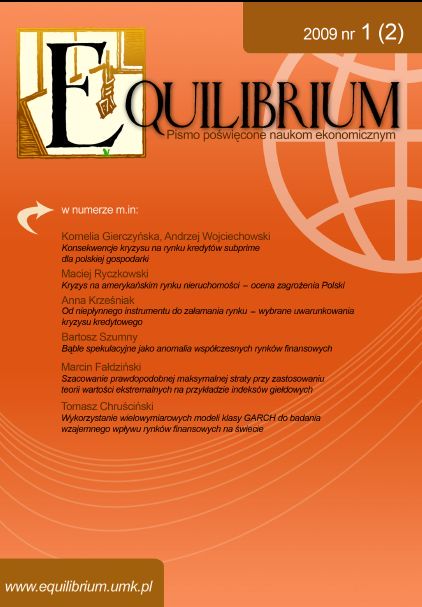From illiquid financial instrument to market distress ? selected institutional circumstances of the credit crisis
DOI:
https://doi.org/10.12775/EQUIL.2009.003Abstract
The recently observed credit crunch is yet another market disruption confirming the critical role of liquidity in the financial system. It is however the first time that illiquidity of a single financial instrument has led to illiquidity of a significant part of the financial system. Although the credit crisis had limited effect on the Polish economy, thorough understanding of the underlying mechanisms is necessary to properly monitor the financial stability in the future, as the Polish financial system gets more integrated into the global one. The article discusses selected mechanisms of the crisis and concentrates on the characteristics of the financial markets that led to the sudden spill-over of the turbulence in the global financial markets. The paper highlights the two types of risk, which were underestimated in the past, but played a major role in instigating and magnifying the recent crisis. The first one is the liquidity risk, which may undermine the reliability of the mark-to-market valuation and produce extreme price volatility once the confidence in such valuations is eroded. The second one is the counterparty risk which results from concentration of market turnover in the period of rapidly growing volumes of derivatives traded in the market. The article leads to the conclusion that the lack of transparency and liquidity on the credit risk markets triggered the severe financial crisis in the global financial market. The analysis of the liquidity risk and the counterparty risk illustrates that some institutions became crucial for the functioning not only domestic but also global markets.
Downloads
References
BIS, Fair value measurements and modeling: An assessment of challenges and lessons learned from the market stress, ?Basel Committee on Banking Supervision?, 2008
BIS, Ratings in structured finance: what went wrong and what can be done to address shortcomings?, ?Committee on the Global Financial System Papers?, 32,2008
Fender I., Kiff J., CDO rating methodology: some thoughts on model risk and its implications, ?BIS Working Paper?, 163, 2004, s.9-13
?Financial Times?, wybrane artykuły z 2008 roku, www.ft.com (10.10.2008 i 13.11.2008)
IFLS, Derivatives 2007, www.ifls.org.uk/research (12.10.2008)
Gibson, M.S. Credit Derivatives and Risk Management, ?Finance and Economics Discussion Series?, FED, 47, 2007
IMF, Financial Stress, Downturns and Recoveries, ?World Economic Outlook, October 2008?, 2008
Sławiński, A. ?Rynki Finansowe?, PWE, 2006
Sławiński, A. Przyczyny i konsekwencje kryzysu na rynku papierów wartościowych emitowanych przez fundusze sekurytyzacyjne, ?Bank i Kredyt?,12, 2007
Weithers, T. Credit Derivatives, Macro and Systemic Risks, ?Federal Reserve Bank of Atlanta Economic Review?, 4, 2007






